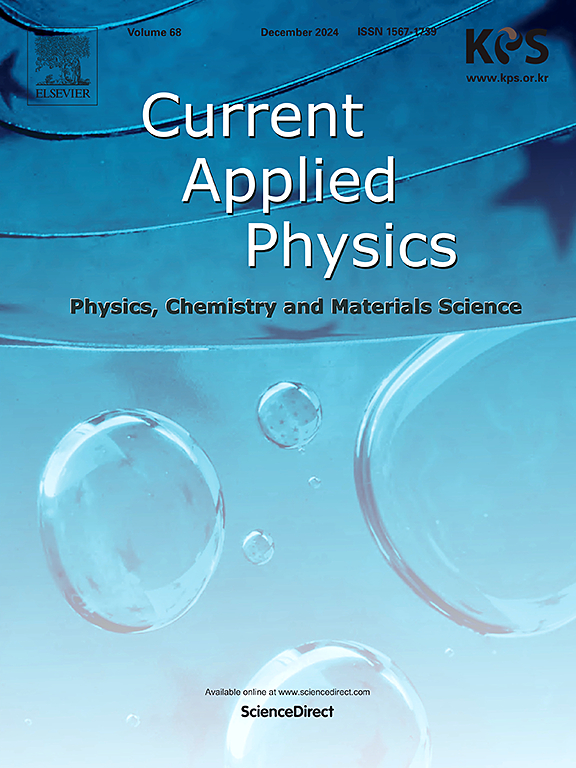WO3/BiVO4/TiO2异质结构光催化剂的制备与表征
IF 2.4
4区 物理与天体物理
Q3 MATERIALS SCIENCE, MULTIDISCIPLINARY
引用次数: 0
摘要
利用半导体光催化剂和太阳能进行光电化学水分解析氢是一种非常有前途的可持续能源生产方法。在各种光催化剂组合中,三氧化钨(WO3)和钒酸铋(BiVO4)的异质结构由于其广泛的可用性、成本效益和合适的带隙能量而引起了PEC应用的关注。WO3和BiVO4之间形成异质结,促进了电荷的分离和转移,提高了整体光催化性能。然而,它们的性能受到水溶液稳定性差的影响。为了解决这个问题,研究人员添加了二氧化钛(TiO2)顶层,通过防止与电解质直接接触来增强光阳极的稳定性。采用水热法和旋涂法在FTO衬底上制备了WO3/BiVO4/TiO2三层异质结构。系统地分析了光阳极的晶体结构、形貌、光学性能和PEC性能。WO3/BiVO4/TiO2异质结构表现出优异的光开关性能,稳定性测试证实TiO2层有效地保护底层免受光腐蚀,提高了长期效率。本文章由计算机程序翻译,如有差异,请以英文原文为准。
Fabrication and characterization of heterostructure WO3/BiVO4/TiO2 photocatalyst for efficient performance of photoelectrochemical water splitting
Hydrogen evolution through photoelectrochemical (PEC) water splitting using semiconductor photocatalysts and solar energy is a highly promising method for sustainable energy production. Among the various photocatalyst combinations, the heterostructure of tungsten trioxide (WO3) and bismuth vanadate (BiVO4) has garnered attention for PEC applications due to its wide availability, cost-effectiveness, and suitable bandgap energy. The formation of a heterojunction between WO3 and BiVO4 improves charge separation and transfer, enhancing the overall photocatalytic performance. However, their performance is hindered by poor stability in aqueous solutions. To address this, a titanium dioxide (TiO2) top layer was added to enhance the photoanode's stability by preventing direct contact with the electrolyte. A triple-layered WO3/BiVO4/TiO2 heterostructure was fabricated via hydrothermal and spin-coating methods on an FTO substrate. The crystal structure, morphology, optical properties, and PEC performance of the photoanodes were systematically analyzed at each fabrication step. The WO3/BiVO4/TiO2 heterostructure demonstrated excellent photo-switching performance, and stability tests confirmed that the TiO2 layer effectively protected the underlying layers from photo corrosion, improving long-term efficiency.
求助全文
通过发布文献求助,成功后即可免费获取论文全文。
去求助
来源期刊

Current Applied Physics
物理-材料科学:综合
CiteScore
4.80
自引率
0.00%
发文量
213
审稿时长
33 days
期刊介绍:
Current Applied Physics (Curr. Appl. Phys.) is a monthly published international journal covering all the fields of applied science investigating the physics of the advanced materials for future applications.
Other areas covered: Experimental and theoretical aspects of advanced materials and devices dealing with synthesis or structural chemistry, physical and electronic properties, photonics, engineering applications, and uniquely pertinent measurement or analytical techniques.
Current Applied Physics, published since 2001, covers physics, chemistry and materials science, including bio-materials, with their engineering aspects. It is a truly interdisciplinary journal opening a forum for scientists of all related fields, a unique point of the journal discriminating it from other worldwide and/or Pacific Rim applied physics journals.
Regular research papers, letters and review articles with contents meeting the scope of the journal will be considered for publication after peer review.
The Journal is owned by the Korean Physical Society.
 求助内容:
求助内容: 应助结果提醒方式:
应助结果提醒方式:


